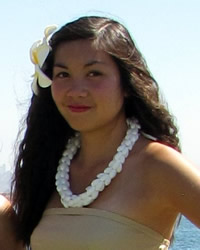The Chamorro, Guam's indigenous inhabitants, first populated the island approximately 4,000 years ago. The island has a long history of European colonialism beginning in 1668 with the arrival of Spanish settlers including Padre San Vitores, a Catholic missionary. The island was controlled by Spain until 1898, when it was taken over by the United States during the Spanish American War. As the largest island in Micronesia and the only American-held island in the region before World War II, Guam was occupied by the Japanese in December 1941, and was subject to fierce fighting when American troops recaptured the island in July 1944.
Today, Guam's economy is mainly built upon tourism (primarily from Japan) and US military bases. The official languages of the island are English and Chamorro.
Guam is the southernmost island in the Mariana island chain and is the largest island in Micronesia. The island of Guam is 30 miles long and 4 to 12 miles wide. The island experiences occasional earthquakes due to its location on the western edge of the Pacific Plate. In recent years, earthquakes with epicenters near Guam have had magnitudes ranging from 5.0 to 8.7. Guam has no active volcanoes.
The island's population is most dense in the northern and central regions. The 2007 population estimate for Guam is 173,460 with an estimated annual population growth rate of 1.76%. The largest ethnic group is the native Chamorro people accounting for over half of the total population. Other significant ethnic groups include Filipino (one-quarter), Caucasian (one-tenth), and smaller groups of people of Chinese, Japanese, and Korean ancestry.
The climate on Guam is characterized as tropical marine. The weather is generally hot and very humid with little seasonal temperature variation. The average high temperature is 86 F (30 C) and average low is 76 F (24 C) with an average annual rainfall of 96 inches. The dry season runs from December through June. The remaining months constitute the rainy season. The months of January and February are considered the coolest months of the year with overnight temperatures in the low 70s and lower humidity levels. The highest risk of typhoons is during October and November although they can occur year-round.
Traditional Chamorro culture is visually manifested in dance, unique cuisine, fishing, games, songs, and fashion. Some of these elements of their culture may have been influenced to varying degrees by the immigration of people from other lands.
Spanish policy during colonial rule (1668-1898) was one of conquest and conversion to Roman Catholicism. This led to the gradual elimination of Guam's male warriors and displacement of some of the Chamorro people from their lands. Some Chamorro today have Spanish, Mexican, Filipino, and American ancestry. Chamorro have Spanish surnames because of their conversion to Roman Catholicism. Guam's matriarchs continued the indigenous culture, language, and traditions. Much of the Chamorro culture exhibited today has roots in Spanish, Mexican, and Filipino cultures. In fact, cockfighting, a sport popular in Mexico and the Philippines, is an accepted cultural tradition dating back to the Spanish rule.
The Chamorro culture is based upon a complex social protocol centered upon pluralism as opposed to individualism and the offering of respect to others. Examples of expressions of their culture include kissing of the hands of the elders, passing legends verbally to the next generation, chanting, courtship rituals, and requesting forgiveness from spiritual ancestors when entering a jungle or ancient battlegrounds. Other practices predating Spanish conquest include canoe-making, making stringed musical instruments from gourds, fashioning slingshots, manufacturing tools, burial rituals, and the preparation of herbal medicines by the shaman. Master craftsmen and women specialize in weaving all types of baskets, mats, apparel, jewelry, and burial shrouds.
The cosmopolitan nature of modern Guam poses challenges for Chamorro struggling to preserve their culture and identity amidst western modernization.
Commonly referred to as "America in Asia", Guam is a popular destination for Japanese tourists. Its tourist hub, Tumon, features 20 large hotels, a duty-free shopping district, indoor aquarium, Las Vegas-style shows, and other shopping and entertainment venues. Guam is a relatively short flight from Asia or Australia compared to Hawaii. Its hotels and golf courses accommodate over a million tourists per year. Although 90 percent of the tourists are Japanese, Guam receives a sizable number of tourists from South Korea, Philippines, and Taiwan.
The Commercial Port of Guam is the island's lifeline since all consumer products must be shipped into Guam. The Port is also the regional distribution hub for over 500,000 consumers throughout the Micronesian region.
Roman Catholicism is the predominant religion on Guam.
The Chamorro also rely upon traditional beliefs in shaman who are skilled in conducting healing and medicinal rituals. Belief in spirits of ancient ancestors, TaoTao Mona, also serve as a remnant of pre-European Chamorro society.
A planned U.S. military buildup (2010-2014) would cause an unprecedented population increase (approximately one-quarter or 40,000 plus residents) which would significantly impact Guam's very limited and aging infrastructure. It would also offer new opportunities for some and challenges for others. The Chamorro people would likely see this as an affront to their continuing struggle to maintain and preserve their historical culture.
Guam, like any other inhabited land mass, needs people to represent Biblical Christianity. Great opportunities exist on Guam due to its level of westernization and acceptance of the concept of Christianity.
Pray for a clear, consistent, and persistent presentation of Biblical Christianity for Guam.
Pray for workers who will enter and persist in this field of opportunity.
Scripture Prayers for the Chamorro in Guam.
| Profile Source: Wallace Revels |










